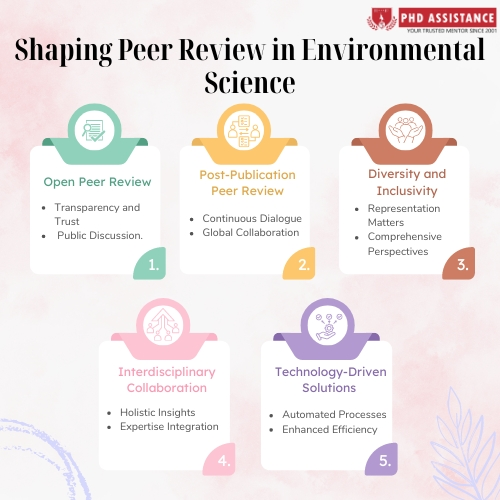Trends Shaping Peer Review Processes in Environmental Science: Stay advanced!
Hey there, fellow science enthusiasts! Have you ever felt like your groundbreaking research gets stuck in a bottleneck called peer review? Well, fear not, because the landscape of peer review is shifting faster than ever, especially in the realm of environmental science. Buckle up and let’s ride this wave together!
Introduction:
Picture this: you’ve poured your heart and soul into a research paper on ocean acidification, but before you can share your findings with the world, you hit a roadblock called peer review. But fear not, my fellow researchers! Today, we’re diving deep into the trends shaping peer review in environmental science and how you can navigate these waters like a pro.

Courses Shaping Peer Review Processes:
Directions shaping peer review include open peer review for transparency, post-publication review for ongoing dialogue, diversity and inclusivity efforts, interdisciplinary collaboration, and technology-driven solutions like AI and blockchain. These trends aim to enhance scientific rigor and inclusiveness in environmental science research. (Katz & Plevin, 1998)
Open Peer Review: As Dr. Michael Willis once said, “Openness in peer review not only enhances the quality of research but also builds bridges of trust among researchers.” So, say goodbye to the days of mystery reviewers hiding behind closed doors. Open peer review is all about transparency, making reviews and reviewer identities public. It’s like having a scientific discussion out in the open, where everyone can join in and contribute their two cents.
Post-Publication Peer Review: Who says the conversation ends once your paper is published? with post-publication peer review platforms, the dialogue continues long after your research hits the shelves. It’s like having a never-ending brainstorming session with colleagues from around the world, helping you refine your ideas and stay on the cutting edge. (McNeill et al., 2020)
Diversity and Inclusivity: Science is for everyone, and peer review should reflect that. That’s why there’s a growing push for diversity and inclusivity in reviewer panels by way of bringing together voices from different backgrounds and perspectives, we can ensure that all angles are considered, and no stone is left unturned.
Interdisciplinary Collaboration: Environmental science is like a puzzle with pieces scattered across multiple disciplines, peer review is catching up by bringing up interdisciplinary collaboration among reviewers. It’s like assembling a dream team of experts from different fields, each bringing their unique perspective to the table.
Technology-Driven Solutions: From AI algorithms to blockchain platforms, technology is revolutionizing peer review. Imagine a world where screening for conflicts of interest is automated, and the review process is streamlined for efficiency. It’s like having a personal assistant who takes care of the nitty-gritty so you can focus on the big picture. (Livoreil et al., 2017)
So, does it mean anything to us? OfCourse! peer review is no longer a hurdle to overcome but a wave to ride, embrace openness, dive into post-publication discussions, champion diversity, and harness technology. Together, we can navigate these changing tides and pave the way for a more inclusive and rigorous scientific community.
Solutions:
Ready to ride the wave of change? Here’s your surfboard:
– Dive into Openness: Seek out journals that embrace open peer review and join the conversation.
– Catch the Post-Publication Wave: Don’t let your research gather dust – engage with post-publication peer review platforms to keep the dialogue alive.
– Champion Inclusivity: Advocate for diverse representation in peer review panels and support initiatives that promote inclusivity.
– Embrace Technology: Explore innovative tools and platforms that leverage technology to streamline peer review and enhance scientific discourse.
Conclusion:
As the tides of peer review continue to shift, it’s up to us to grab our surfboards and ride the wave of change by embracing openness, diversity, and technology-driven solutions, we can navigate these waters with confidence and propel scientific progress forward. So, hang ten, my fellow researchers, and let’s catch that next big wave together!
Reference :
- Environmental Sciences: Books and Journals | Springer. (n.d.). Www.springer.com.
- Environment Research Databases | Environmental Studies Journals | EBSCO. (n.d.). Www.ebsco.com. Retrieved May 13, 2024, from (Environment Research Databases | Environmental Studies Journals | EBSCO, n.d.)
- McNeill, K., Novak, P. J., & Vikesland, P. J. (2020). 2019 Best Papers published in the Environmental Science journals of the Royal Society of Chemistry. Environmental Science: Processes & Impacts, 22(4), 860–862.
- Katz, J. S., & Plevin, J. (1998). Environmental science in the UK: A bibliometric study. Research Evaluation, 7(1), 39–52.
- Livoreil, B., Glanville, J., Haddaway, N. R., Bayliss, H., Bethel, A., de Lachapelle, F. F., Robalino, S., Savilaakso, S., Zhou, W., Petrokofsky, G., & Frampton, G. (2017). Systematic searching for environmental evidence using multiple tools and sources. Environmental Evidence, 6(1).



